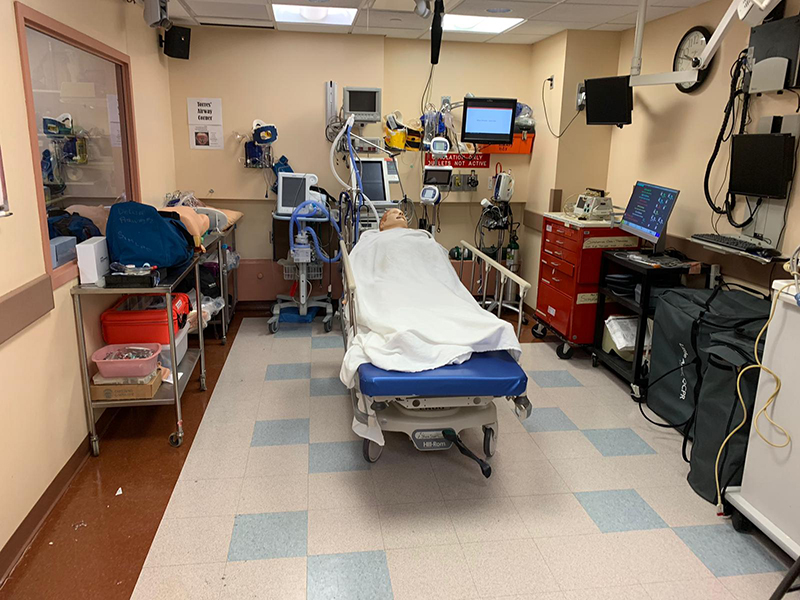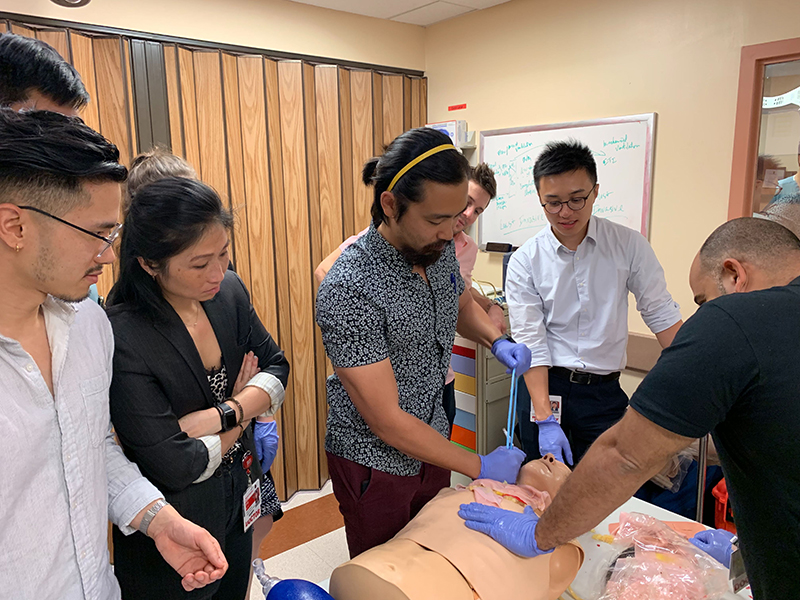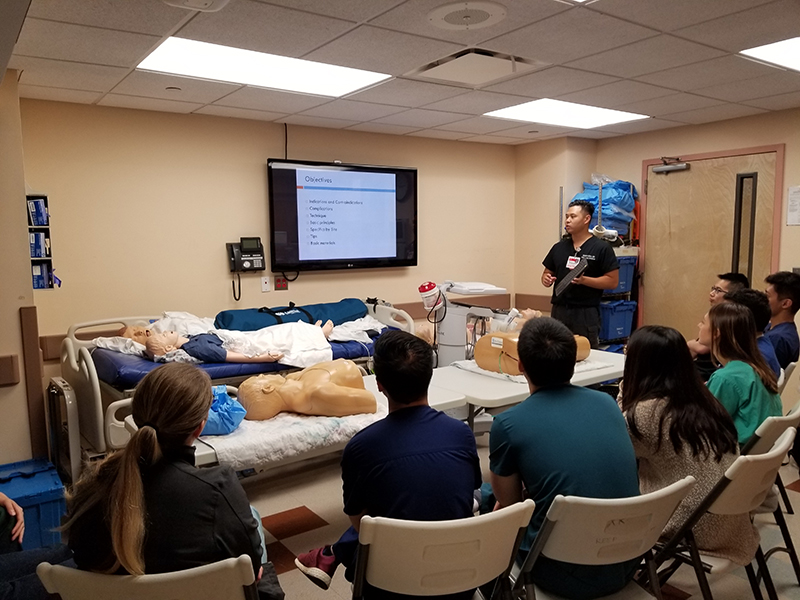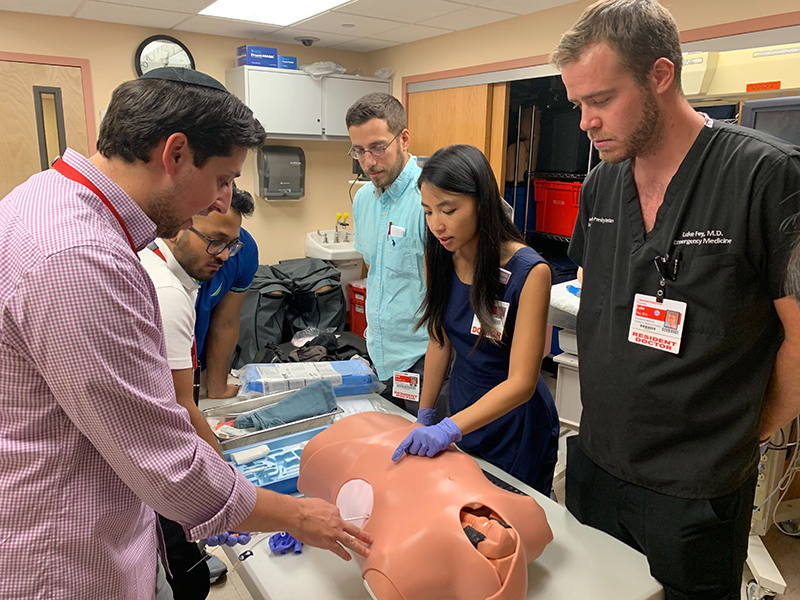Simulation Clerkship
The ability to think quickly, make critical decisions, and perform tasks effectively in a critical care setting is an essential part of Emergency Medicine. During this rotation at New York-Presbyterian/Queens, you will have the opportunity to implement life-saving actions, which involve emergent procedures, consultations and coordination of care in a patient-safe, high-fidelity, unstable situation in Medical Simulation (SIM). Emergent procedures include central vascular access, intubation, cricothyrotomy, tube thoracostomy, pericardiocentesis, BLS, ACLS and PALS resuscitations.
By the end of this elective, you will be able to:
- Develop emergency medicine and critical care decision-making skills
- Develop emergency medicine and critical care procedural skills
- Create, execute and assist in debriefing of a medical simulation case
Clinical activities
You will interview patients, perform physical exams, establish a differential diagnosis and initiate treatment plans under the guidance of a resident and an emergency attending physician in the Critical Care and Trauma Bay. You will work one-on-one with an emergency attending physician-led team on every shift.
You will have the opportunity to conduct procedures appropriate for your level of training. These include phlebotomy, vascular access, nasogastric tube placement, percutaneous endoscopic gastrostomy tube replacement, foley catheter placement, laceration repair, wound care, and splinting of fractures or sprains. All procedures will be conducted under the direct supervision and guidance of a resident or attending physician. If you do not have experience in conducting these procedures, one of our talented residents or attending physicians will be more than happy to teach you.
You are also strongly encouraged to participate in medical and trauma resuscitations to the best of your ability under the guidance of an attending physician.
SIM activities
Your scholarly activities will include:
- Participation in group SIM cases using our SimMan 3G
- Learn and perform emergent procedures on task-trainers
- A one-on-one simulation session with a SIM faculty member
- Design, write-up, and execution of your own SIM case
You will be using the MedEd Portal format for designing your own case with the guidance of SIM faculty. You will then use this case write-up to execute a medical simulation case among your current group of medical students and select residents. Using the framework of the PEARLS Debriefing Tool, You will take part in medical simulation debriefing, which is where the learning happens.
This is also an opportunity to have your work published!
Didactics
On Mondays and Tuesdays, if you are scheduled on a clinical shift, you will be  working with The Education Team from 11 AM to 1 PM. The Education Team travels throughout the various sections of the ED and learns from active educational cases referred by clinically working ED providers. Educational cases might include a rare physical exam finding, a rare clinical diagnosis, an educational EKG, or an educational radiology image/ultrasound. Physical exam and ultrasound education will typically occur at the patient's bedside. EKG interpretation, radiology interpretation, and other EM education will typically occur at computer stations in the ED.
working with The Education Team from 11 AM to 1 PM. The Education Team travels throughout the various sections of the ED and learns from active educational cases referred by clinically working ED providers. Educational cases might include a rare physical exam finding, a rare clinical diagnosis, an educational EKG, or an educational radiology image/ultrasound. Physical exam and ultrasound education will typically occur at the patient's bedside. EKG interpretation, radiology interpretation, and other EM education will typically occur at computer stations in the ED.
On Wednesdays, from 9 AM to 2 PM, there is a mandatory conference weekly for the residents and medical students.
On Thursdays, students will participate in additional high-yield, interactive didactic sessions specifically created for their level of education. This weekly Thursday conference is run by the residents, fellows, and clerkship director, and is made specifically for our students to allow for optimal learning opportunities.
End-of-rotation presentation
On the last Friday of your rotation, you will present an interesting case in the  form of a 10-minute case report. Students present a brief HPI, past medical history, pertinent surgical, family and social history, and a physical exam. Students then formulate a differential diagnosis, determine which diagnostic tests are to be performed, and then discuss the results, final diagnosis, and the disposition of the patient. This is the most common style of presentation but you are not restricted to this format. Alternatively, you may review an interesting procedure or recent literature. Feel free to be creative. Audio-visual aids are not required but are frequently utilized.
form of a 10-minute case report. Students present a brief HPI, past medical history, pertinent surgical, family and social history, and a physical exam. Students then formulate a differential diagnosis, determine which diagnostic tests are to be performed, and then discuss the results, final diagnosis, and the disposition of the patient. This is the most common style of presentation but you are not restricted to this format. Alternatively, you may review an interesting procedure or recent literature. Feel free to be creative. Audio-visual aids are not required but are frequently utilized.
How to apply
NewYork-Presbyterian Queens uses the AAMC's Visiting Student Learning Opportunities (VSLO). We receive and review applications on a rolling basis. We recommend applying as early as possible, especially for rotations during the summer and early fall.
To find our rotation on VSLO:
- Go to the VSLO Search for Electives form
- Select Weill Cornell Medicine from the Institution Menu
- Select NewYork Presbyterian-Queens from the Site Menu
- Click Search
- Our Fourth year EM elective is designated EMER.8006.NYQ — Emergency Medicine and Critical Care Simulation at New York-Presbyterian Queens
For more information, contact

Sheetal Sheth, DO

Sheetal Sheth, DO



